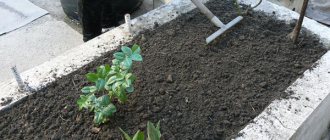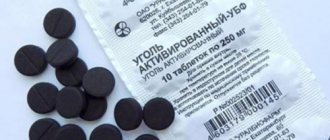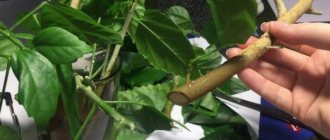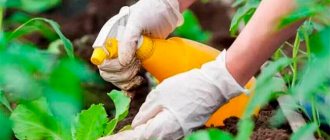How is Epin useful for plants?
First of all, it is important to understand that this is not a medicine or a fertilizer. Epin is not a universal protection for plants; it does not nourish them with additional substances and does not treat them when infected with fungi or viruses.
The benefit of the product lies in its ability to increase the defense capacity of the plant cell to the negative effects of chemical, biological and physical irritants.
In terms of its composition and action, the product belongs to adaptogens, which activate the awakening of the body's reserve forces, awakening dormant cells for subsequent growth and development.
As a result of this impact, resistance to the negative influence of an aggressive external environment increases, which significantly affects the level of productivity. Thus, as a result of treating seeds with a solution before planting, their level of similarity and the amount of harvest increases by 15%.
The main active ingredient of the drug is epibrassinolide. This substance is identical to brassinolides, which are contained in every plant cell and are responsible for cell survival under unfavorable environmental conditions.
Despite the fact that brassinolides are now being extracted from natural raw materials, this is a rather costly process in terms of finances and raw materials. Therefore, synthetic epibrassinolide does not lose popularity.
Description of the drug
The full name of the drug is 2,4-epibrassinolide. This is a synthetic phytohormone that activates the reserve functions of living cells.
Sold in the form of a solution with a concentration of 0.25 mg of active substance per 1 ml. Packaged in millimeter ampoules for indoor flowers and summer cottages and up to 1 liter for large areas.
Depending on how exactly the mixture is planned to be used, it is important to observe the dosage of the solution. It is important to consider that a lot is not always good and to strictly follow the instructions for using the chemical.
Let's watch a video about what Epin is for plants and how it is used:
How to use Epin for seedlings
The consumption of the product is calculated taking into account the crop, but it can be used at any stage of its cultivation. Calculation of dosage and watering of seedlings with Epin is carried out according to the instructions: dilute the stimulant with filtered water, store for no more than 24 hours.
In a room protected from sunlight, it does not lose its properties for 48 hours. Sprayed seedlings with Epin's solution for seedlings break down its components 1–2 weeks after treatment.
Depending on the manufacturer, the biostimulant is stored for no more than 3 years, subject to storage rules.
How to dilute Epin for spraying seedlings, bulbs, cuttings
Treating the seeds in a solution allows them to stimulate germination and increase the chances of successful rooting of cuttings. Rational calculation of the dosage of Epin for watering seedlings according to the instructions allows you to achieve maximum results.
The solution from the ampoule is mixed with acidified water (0.5 tsp of citric acid is added per 1 liter). Using alkaline water will reduce the effectiveness of the biostimulator.
Application of Epin Extra for seedlings and seeding material:
- Raw vegetable crops (peppers, cucumbers, tomatoes) are soaked for 18–20 hours in the product at room temperature. To do this, dissolve 1-2 drops in 100 ml of water. Epina.
- To treat 50 kg of potato tubers, seedlings are sprayed with Epin using 1 ml of the drug diluted with 250 ml of water.
- The instructions for processing bulbs and cuttings are to dissolve 1 ml of the product in 2000 ml of water and then soak the raw materials for a certain period of time: bulbs for 12 hours, and cuttings for 2 days.
- Flower seeds are immersed for 18–20 hours (4 drops per 100 ml of liquid).
Before treatment with a stimulant, the raw material is wrapped in fabric; after the procedure is completed, it must be planted in suitable soil.
Spraying plants
According to the instructions, the maximum effect from using Epin is achieved by sprinkling the crop before and after budding. It is carried out in the morning and evening hours, when there is no wind or precipitation. Watering the soil with a stimulant is prohibited.
Important! After treating seedlings with Epin, the product quickly evaporates under the influence of sunlight, and the plant may not have time to absorb it, so it is not used during the daytime.
Instructions for using Epin for flower and vegetable seedlings: spray only shoots and leaf blades. Fertilizer absorption takes 3 days, so re-sprinkling is carried out after 14 days. An intact plant is treated three times per season according to the instructions.
It is possible to use Epin for seedlings as an aid in the formation of a strong root system: the crop becomes more hardy. To do this, 6 drops of the drug are dissolved in 500 ml of water, and the finished solution is applied to the sprouts before transferring them to open ground.
Important! Violation of the instructions will lead to an overdose: the active components in the plant will accumulate like pesticides.
Feeding seedlings with Epin
Fertilizer is applied to the soil after 2–4 true leaf blades appear. Feeding seedlings with Epin is carried out according to the following scheme: 0.25 mg per 1000 ml of water. The procedure serves as a prevention of blackleg. Treated seedlings do not stretch and grow with a strong root system.
When picking seedlings with Epin, the culture is sprayed 2–3 hours before dividing the sprouts into containers. The solution (3 drops per 100 ml) allows seedlings to avoid stress.
Epin extra for stress and illness
Unfavorable conditions that can harm the crop are a sharp drop in temperature, prolonged rains, cold snap or drought. They weaken the plant, which slows down its growth and becomes vulnerable to diseases and pests that can negatively affect yield.
Epin is an anti-stress agent: penetrating into the seedling, it stimulates the functioning of its immune system. For the treatment and prevention of diseases, dilute 1 mm of the drug in 5000 ml of water and spray the shoots with leaf blades at intervals of 10 days. The course lasts until the culture has completely recovered.
How to use Epin extra for tomatoes
There are several nuances that should be considered before starting work.
So, depending on the purpose of using the chemical, the dosage also differs:
- In order to soak tomato seeds before planting, it is recommended to dilute 3-4 drops of the drug in 0.1 liters of heated water. Let stand for twelve hours, then immediately begin sowing without rinsing;
- To spray seedlings, it is recommended to use a solution of two drops per glass of water. Carry out processing before picking;
- You can spray before planting seedlings in open ground. To do this, one day before transplanting, you need to prepare a concentrated solution of six drops of biostimulant and a glass of water and spray the tomatoes;
- After the formation of the first buds, it is recommended to treat the bushes with a solution of 5 liters of water and one ampoule of Epin.
The last treatment can be carried out in late summer or early September. This will help the last harvest to withstand possible temperature fluctuations as firmly as possible.
Instructions for use of the drug Epin Extra
The immunomodulator can be used both in agriculture, in the garden, and at home. The drug Epin Extra, according to the instructions for use, is indicated:
- for germination of seed material;
- rooting of seedlings, cuttings;
- during the adaptation period after transplantation;
- in case of weakening of the plant after illness or invasion of pests;
- at low temperatures;
- in dry times or when normal watering is impossible;
- to increase the vitality of perennial crops.
Treatments with the biostimulator Epin Extra are carried out by spraying the above-ground parts of the plant, because the drug is absorbed only through the stems and leaves. The immunomodulator is absorbed within 72 hours. Repeated procedures are carried out no earlier than two weeks later, since during this period the active substance disintegrates. In the absence of diseases and stress factors, it is enough to process the crops three times per season.
Treatment with biostimulator Epin Extra
The use of the adaptogen Epin Extra for weakened or post-stress plants is carried out every 7-10 days until the crops are completely regenerated with a solution in a concentration of 70-80 drops per 1 liter of water.
Expert opinion
Oksana Alexandrovna
A gardener with extensive experience. Vegetable gardening is more than just a hobby for me.
The immunomodulator is used no earlier than 24 hours after the pesticide.
The biostimulator decomposes in light, so treatments must be carried out in the evening or in cloudy weather.
For spraying, the working liquid is prepared by dissolving the drug in water at room temperature. If the pH is greater than 7, then add a little citric acid or a few drops of table vinegar to the solution.
The liquid prepared for spraying must be used no later than two days. The maximum effect is achieved when treated 10 minutes after diluting the drug. The working solution must be stored in a tightly closed glass container in a cool, dark place. If light penetrates into the room, the shelf life is reduced to one day.
Application of Epin Extra for seeds
The seed material is soaked in the adaptogen Epin Extra. The procedure serves to prevent infections and promote faster germination. To do this, the seeds are dipped into the working liquid, wrapped in a napkin or cloth so that the solution slightly covers them. Vegetable crops are kept for 4-6 hours, flower crops - 8-10 hours, bulbs - 24 hours, cuttings - 12 hours.
Epin Extra for seeds of cucumbers, zucchini, parsley, eggplant, peppers, tomatoes, onions and flowers, the concentration of the drug will be: 20 drops per 0.5 liter of water.
A biostimulator for plant cuttings, bulbs and rhizomes, as well as seeds of beets, carrots, and celery is dissolved at the rate of 15 drops per 0.5 liters of water.
Application of Epin Extra for seedlings
The growth stimulator Epin Extra, as indicated in the instructions for use, is used for seedlings 24 hours before planting or one day after it. The procedure promotes rapid rooting, better acclimatization, strengthening of plants and disease prevention.
Application of Epin Extra for seedlings
For vegetable crops, 3-4 drops of the drug per 0.5 liter of water are required.
For flowers - 4-5 drops per 0.5 liters of water.
Application of Epin Extra for potatoes
Potatoes are treated with adaptogen twice. The tubers are sprayed for the first time before planting. The solution is prepared in the following proportion: 1 ml per 5 liters of water. This volume is enough for 500 kg of planting material. The second time - during the budding phase of the plant, the consumption will be: 250 ml per 100 m2.
Application of Epin Extra for coniferous plants
Epin Extra is also used for coniferous plants. They are mainly processed as a preventive measure or for rapid regeneration in case of damage. The concentration of the solution for evergreen crops is 1 ml per 1 liter of water. Working fluid is consumed depending on the density of trees, their size and age.
Application of Epin Extra for coniferous plants
Application of Epin Extra for garden flowers
Biostimulator Epin Extra, in accordance with the instructions, is used for perennial flowers to prepare them for winter. To do this, dissolve 5 drops of the drug in 0.5 liters of water.
Gardeners respond positively to the use of an immunomodulator for treating roses. For spring rooting of tender plants, cuttings are soaked in a solution of 1 ml of adaptogen per liter of water for 24 hours. For 5 pieces, 100 ml of working fluid is enough.
For already growing roses, Epin Extra is used no more than 4 times per season. Thanks to the biostimulator, shrubs bloom 10 days faster than usual. The first treatment is carried out in the spring after removing the winter shelter. Two subsequent sprayings - during the summer. The last procedure is carried out in the absence of frost a week before covering the plant for the winter. Working fluid concentration: 2 ml per bucket of water.
Expert opinion
Oksana Alexandrovna
A gardener with extensive experience. Vegetable gardening is more than just a hobby for me.
The biostimulant promotes long-term preservation of cut flowers. Add 3 drops of the drug to a vase of water.
Application of Epin Extra for indoor plants
Epin Extra is successfully used for indoor plants; its use greatly facilitates the care of home greenhouses. Adaptogen allows newly purchased plants to quickly adapt to a new location, tolerate replanting more calmly, stimulates growth and long-term flowering, and gives vitality to long-grown flowers.
The working solution of Epin Extra for spraying indoor plants, according to the instructions for use, is prepared at the rate of: 5 drops of the drug per 0.5 liter of water. For all types, the procedure is carried out twice.
Flowering crops are treated at the stage of active growth, then after the plant has flowered. Depending on the size, one flower requires 100 ml of working fluid.
Deciduous crops are sprayed at the beginning of the growing season, then in the fall 30 days before the plant enters the dormant stage.
The biostimulator is effective in caring for phalaenopsis orchids. It is used during the active growth phase of the plant, as well as during transplantation or infectious diseases. The drug is diluted in the ratio: 2 ml per 10 liters of water.
Expert opinion
Oksana Alexandrovna
A gardener with extensive experience. Vegetable gardening is more than just a hobby for me.
Epin Extra perfectly helps delicate exotic flowers such as azaleas, lady's slippers, orchids, cattleyas, and vandas to cope with stress factors.
How to breed Epin for orchids and violets
Before you start treating delicate plants such as violets and orchids with a biostimulant, it is important to take into account several nuances.
So, first of all:
- The substance should be diluted in a ratio of 0.2 ml per liter of water;
- Do not water the flowers under any circumstances, only spray them;
- Before preparing the solution, it is recommended to check the water for acidity levels; for this, indicator paper is useful, which can be bought at the pharmacy. Water with a slightly acidic reaction, not higher than pH = 6.2-6.8, is considered suitable;
- After processing, it is recommended to place the flowers in a darkened room for a day;
- During planned treatment, it is recommended to apply root fertilizer for flowers several days before spraying; to combat pests, you can spray Epin a day after treatment with the main chemical.
It is recommended to treat only the foliage, since the soil for orchids and violets is quite loose and already contains a sufficient amount of nutrients. The latter simply negates all the positive effects of the drug.
When spraying, it is recommended not to neglect not only the leaves, but also the stems, peduncles and roots. But it is not recommended to spray flowers, just as when replanting, treatment with a biostimulant will be unnecessary.
Violets and orchids are equally beautiful and equally delicate flowers, so compliance with the rules of processing and dosage is a vital aspect that should not be ignored.
Application for different crops
Tomatoes
To soak the seeds, use a solution of 3-4 drops of Epin per 100 ml of warm water. The seed is kept for 12 hours, then immediately sown without washing.
Now let's figure out how to use Epin for tomato seedlings:
- To spray tomato seedlings before picking, use a solution of two drops of the product per glass of water.
- According to reviews from gardeners, tomato seedlings can be sprayed the day before planting in the ground or immediately after this procedure. The solution is made more concentrated: add 6 drops of the product to a glass of water. Plants are treated with the same solution before frost.
- When buds form on the tomatoes, one ampoule of the biostimulant is dissolved in 5 liters of water to treat the plantings.
- The last time Epin, according to gardeners, is used on tomatoes is at the end of August or September, when it is time for cold fogs.
Peppers and eggplants
When growing peppers, a biostimulant is also used. For pepper seedlings, Epin is used according to the instructions. The processing steps and dosage of the drug are identical to tomatoes.
Pumpkin crops
This crop includes cucumbers, zucchini and pumpkin. Peculiarities of cucumber processing:
- First, the seed is treated in a pink solution of potassium permanganate, then in a biostimulator for 12-18 hours. The solution consists of 100 ml of warm boiled water and 4 drops of biostimulant.
- Cucumbers should be sprayed when 3 true leaves appear, or before transplanting if the plants were grown in a nursery. Epin for cucumber seedlings is diluted as follows: add 6 drops of the product to 200 ml of water.
- The same solution is sprayed on cucumbers during the budding phase and the beginning of flowering.
- Then the treatments are repeated several more times every 2 weeks.
Strawberries
- Before planting seedlings of this crop, they are soaked in a biostimulant solution in a proportion of 0.5 ampoule per 1000 ml of water.
- Seven days after planting, strawberry seedlings are sprayed with the following Epin solution: one ampoule is dissolved in five liters of water.
- The next treatment is carried out when the strawberries produce buds and begin to bloom, with the same composition.
Strawberry plantings are treated in the spring to save the plants from frost after harvesting last year's leaves by dissolving 1 ampoule of biostimulant in 5 liters of water. In the fall, when the harvest is harvested and the leaves are cut, strawberries are sprayed with a more concentrated composition: 4-6 drops of Epin Extra are dissolved in a glass of water. You can also treat the plantings in October (dissolve an ampoule in 10 liters of water) if a winter with little snow is expected. This will increase the immunity of strawberries.
Biostimulator for flowers
According to gardeners, Epin is also useful for flower seedlings. Dilute the product according to the instructions. 8-10 drops of biostimulant are dissolved in a liter of water. 500 ml of the resulting solution is enough to treat 10 square meters. Spray flowers after planting in a permanent place to reduce stress, quickly adapt and take root. You can repeat the treatment after two weeks with the same solution composition.
Attention! To spray petunia seedlings, Epin is diluted in the same way as for any flowers, according to the instructions.
Is it possible to water indoor flowers with Epin?
Watering the soil with any chemical leads to its enrichment with by-products. When applying fertilizers, this is a targeted process of enriching flowers with those nutrients that they lack for normal growth and development. However, it is important to consider that Epin is not a fertilizer.
By stimulating the work of plant cells, the drug is useful when spraying and before planting. This helps to activate seed germination and strengthen foliage and flower stalks.
Since the soil in which indoor flowers grow cannot be absolutely neutral, it already contains enough by-products, watering indoor flowers with a chemical can lead to the development of a chemical reaction that will negatively affect the condition of the plant.
It is important to consider that even with spraying, which will be much more appropriate than direct watering, compliance with the dosage is the main point.
Even a slight deviation from the norm can negatively affect the growth and development of the plant.
Watering indoor plants after planting them in the ground is not advisable, as it can lead to a number of unpleasant consequences.
When spraying, the dosage is important; you can reduce the concentration, but in no case increase it.
Let's watch a video about using Epin-extra for plants:
https://youtu.be/GFPf34SJbJ8
Analogues of Epin Extra
Among similar drugs are: HB-101, Gibberrellin, Zircon, Heteroauxin, Kornevin. Epin Extra differs from them in its effect on plants. It activates the culture's own resources, while increasing natural defenses. Growth stimulants such as Heteroauxin and Kornevin forcefully induce growth processes and start flowering. Many gardeners note better results from using Epin Extra with a more gentle effect.
The innovative drug Epin Extra helps reduce the risks of stress factors on garden and ornamental crops, which makes caring for plants much easier. In addition, the biostimulator is harmless and promotes a more generous harvest.
Features of use, precautions
One of the main features of Epin, which sets it apart from other drugs, is its good compatibility with other drugs.
So, it can be used simultaneously with vitamins, fertilizers, and growth stimulants. Spray immediately after treatments with insecticides and fungicides.
The only thing that is important to consider when using the drug is its poor compatibility with products with an alkaline reaction. That is why, before mixing the main drug with Epin in a large amount, it is recommended to carry out a preliminary test by mixing the products in a small amount.
This will help determine the level of compatibility of substances and protect the plants. Ideally, when purchasing chemicals, you should clarify in advance what their compatibility is with a specialist.
Since this biostimulant is a chemical drug, failure to take precautions when using it is very dangerous.
So, when working with the solution, it is recommended to pay attention to the following points:
- Processing must be carried out using personal protective equipment;
- Do not drink, smoke or eat while working. During the spraying process, not all of the water dust settles on the foliage; a certain percentage falls on the worker. Its further penetration into the body leads to poisoning, followed by a number of unpleasant symptoms and consequences;
- After work, be sure to thoroughly wash your face, hands with soap, rinse your mouth and nasal cavity.
In addition to proper use, proper storage of the drug is also important. It is recommended to place purchased ampoules in a dry place where the temperature does not fall below +14 C and does not rise above +23 C.
It is recommended to place the product as far as possible from food, out of reach of small children and animals.
Considering the easy flammability of the product, you should not place it near heating devices.
Despite the precautions, this biostimulant cannot be called extremely dangerous. So the drug is absolutely safe for fish and does not lead to soil degradation or death of beneficial insects.
Compatibility with other drugs
Using the product according to the instructions with other products allows you to provide the plant with complete protection and cure it from diseases. It can be diluted in the same container with fertilizers and pesticides.
Epin is well compatible with the following products:
- Decis;
- Zircon;
- Polisher;
- Fitoverm.
Simultaneous mixing of the biostimulant with fertilizers that have an alkaline environment is not allowed.
A biostimulant is a common biostimulant with a wide range of uses that can restore and support a plant as it develops. Proper care and feeding will allow you to get maximum yield without much effort and money.











